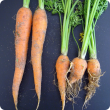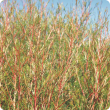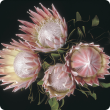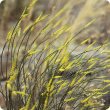Crops
The Department of Primary Industries and Regional Development continues to support the growth and international competitiveness of all crop industries in Western Australia.
With a 2400 kilometre span from its tropical north to its temperate south, WA supports a broad range of cropping industries from rain-fed winter cereals through to irrigated horticultural crops.
In the 2012/13 year the WA cropping industries exported a total of $3.9 billion which comprised: $3.1 billion of cereals, $859 million of pulses, pastures and oilseeds, $142 million of horticultural crops. The major contributors to these exports were wheat ($2.7 billion), canola ($756 million), barley ($377 million), lupins ($42 million), carrots at $48 million, oats ($12 million), and strawberries at $5.5 million.
Filter by search
Filter by topic
- (-) Remove Nursery & cutflowers filter Nursery & cutflowers
- Horticulture (37) Apply Horticulture filter
- Pests, weeds & diseases (17) Apply Pests, weeds & diseases filter
- Biosecurity & quarantine (11) Apply Biosecurity & quarantine filter
- Biosecurity (11) Apply Biosecurity filter
- Production & postharvest (10) Apply Production & postharvest filter
- Fruit (10) Apply Fruit filter
- Diseases (10) Apply Diseases filter
- Plant biosecurity (9) Apply Plant biosecurity filter
- Pests (8) Apply Pests filter
- Fungi (6) Apply Fungi filter
- Vegetables (6) Apply Vegetables filter
- Postharvest (5) Apply Postharvest filter
- Pest insects (5) Apply Pest insects filter
- Viruses & virus-like (3) Apply Viruses & virus-like filter
- Stone fruit (3) Apply Stone fruit filter
- Grapes & wine (3) Apply Grapes & wine filter
- Plant nutrition (3) Apply Plant nutrition filter
- Tomatoes (2) Apply Tomatoes filter
- Potatoes (2) Apply Potatoes filter
- Citrus (2) Apply Citrus filter
- Pastures (2) Apply Pastures filter
- Pome fruit (1) Apply Pome fruit filter
- Pasture management (1) Apply Pasture management filter
- Nematodes (1) Apply Nematodes filter
- Pumpkin (1) Apply Pumpkin filter
- Quarantine (1) Apply Quarantine filter
- Weeds (1) Apply Weeds filter
- Water management (1) Apply Water management filter
- Water (1) Apply Water filter
- Mites & spiders (1) Apply Mites & spiders filter
- Lettuce (1) Apply Lettuce filter
- Climate, land & water (1) Apply Climate, land & water filter
- Carrots (1) Apply Carrots filter
- Capsicums and chillies (1) Apply Capsicums and chillies filter
- Control methods (1) Apply Control methods filter
- Fertiliser (1) Apply Fertiliser filter
- Irrigation (1) Apply Irrigation filter
- Irrigated crops (1) Apply Irrigated crops filter
- Grains (1) Apply Grains filter
- Minor fruits (1) Apply Minor fruits filter













